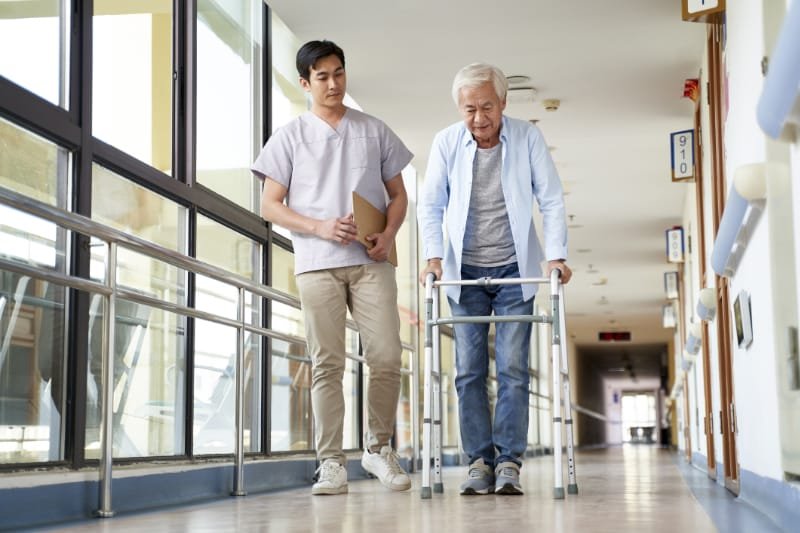Essential Gait Training Exercises For Elderly
Falls can be extremely dangerous to older adults. Although falling is not a normal part of aging, there are certain factors that can increase the risk of falls for older people. These include deteriorating eyesight as well as illnesses and physical conditions that affect strength and balance. According to the Center for Disease Control (CDC), of the 36 million falls by older adults that are reported each year, 3 million result in emergency room visits, and 32,000 are fatal. These are scary statistics, but the good news is that there are things you can do to decrease your risk of falling, such as keeping your home well lit and removing throw rugs or tacking down carpet edges. Gait training also helps to prevent falls, as it strengthens muscles and improves stability.
What is gait training?
Gait training is a type of physical therapy that aims to improve strength and balance in your lower body so you can walk normally and safely. Your gait is the mechanics of your walk. It’s the cycle of repetition involving the coordinated efforts of your feet, knees and hips. Gait training is a set of exercises used to help improve or restore function to this cycle. It also involves your ability to maintain your balance and coordination as you navigate obstacles in the environment. After a stroke, injury, or surgery in the lower extremities, a physical therapist may add gait training exercises to your treatment plan in order to redevelop muscle memory and prevent future falls. Walking itself is a type of gait training, which makes it an excellent exercise for older people, but there are other essential gait training exercises as well.
Essential gait training exercises for the elderly
Gait training isn’t something you should do on your own, particularly if you struggle with balance. It’s best to work with a physical therapist or other healthcare professional who can create a customized set of exercises designed specifically with your needs and safety in mind. There are, however, a few essential gait training exercises that many people can easily do on their own once they've been cleared by their doctor or physical therapist. These include:
Heel raises - Start in a seated position in a chair, with your feet flat on the floor. Point your toes to raise your heels. Do this 10 times.
Increases strength in the calf muscles, helps with balance, and improves ankle mobility.
Toe raises - Start in a seated position in a chair, with your feet flat on the floor. Raise your toes off the ground while keeping your heels connected to the floor. Do this 10 times.
Strengthens shin and ankle muscles, helps with balance, and improves ankle mobility.
Knee to chest (or Seated march) - Start in a seated position in a chair. Raise one knee to your chest, as though you’re marching. Put it down and raise the other knee. Be sure to keep your back straight. Continue until you have raised each knee 10 times.
Strengthens the core, hip flexors, and quadriceps.
One-leg stand - Stand and hold onto a table, a chair, or a wall for support. Lift one foot off the ground and hold it for a few seconds while you balance on the other leg. Try this 10 times on each leg.
Improves balance.
Heel-toe walk - Walk next to a wall or a bar for support. Put your right foot down and then place the left in front of it, with the heel of the left foot directly lined up with the toes of the right. Then put the right foot in front, with the heel directly lined up with the toes of the left. Continue in this way for 15 feet or so.
Improves balance and coordination.
Step-overs / side stepping / figure eights - Place two soft objects on the floor about 3 feet apart. Step over each object several times. Be sure they’re placed at a distance where you naturally step over them with each foot. For side stepping, lift your foot and step sideways over each obstacle several times, leading with each foot an equal number of times. For figure eights, walk around the obstacles in figure eight movements.
Retrains the body for proper movement and lowers the risk of tripping over obstacles.
Even if the above exercises seem simple, it’s important to run them by your doctor or physical therapist before incorporating them into your daily routine. If you have suffered from a stroke, or if you have been ill or injured and have lost some mobility and strength in your lower extremities, chances are, you’ll need gait training. And when you do, Bella Vista is here to help.
Physical therapy and rehabilitation in San Diego
Physical therapy not only improves mobility, strength, and balance to aid independence, but it can also help prevent falls in the future. At the Bella Vista Health Center Physical Therapy Department, our therapists provide specialized gait training programs to help residents recovering from stroke, joint replacement, or other conditions restore lower-limb strength and functioning in order to maximize independence and lower the risk of future falls. If you or someone you love is in need of physical therapy or occupational therapy, give us a call at (619) 644-1000 or come by to visit our 5-Star Skilled Nursing Facility in Lemon Grove Today.





